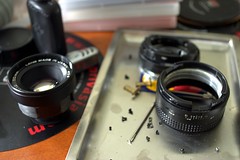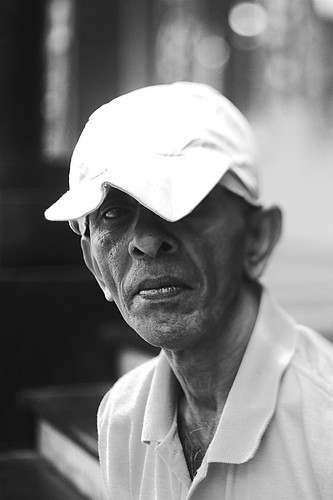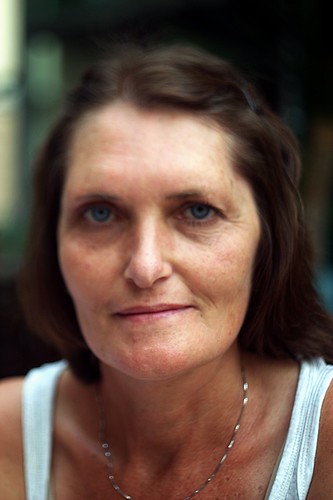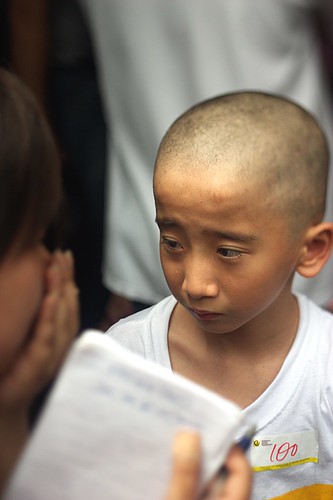Homemade Tilt Shift Lens for Canon 300D
I bought an extremely old Japanese Auto Chinon 50mm prime lens second-hand the other day, so I could play about with creating a new tilt shift lens for my Canon 300D.
I've been playing about with mounting options, and believe it or not the most effective I have found to date is black fibre gaffer tape. It's not a permanent solution at all, but until I find one that is it will have to do.
This is a test shot hurriedly scraped together on the first day or lens creation.
It's a random page of The Economist, taken at an angle. With a normal lens you'd expect a band of words to appear focused, with the foreground and background out of focus, but by angling the lens I was able to almost lay the plane of focus along the page (you’ll notice “Europe” is fuzzy).
As a first attempt it’s great. The lens mount (not sure what it is, but the lens is for a 35mm camera -- Pentax, I think) is much smaller than the opening for the EOS mount, so while the lens needs to settle flush to the body for perfect focus, the smaller mount means I have leeway to move the lens about in the opening.
Not bad for a $20 lens with perfect optics. Lens specs:
50mm
Aperture: f1.9-f16
Focal range: 0.4m - infinity
Manual Focus
What tilt shifting does is allow you to move the plane of focus about in accordance with the Scheimpflug Principle, which as well as allowing perfectly aligned architectural photography (sky scrapers no longer warp to the centre of the frame, but remain straight) but to also mess about and change perception of everyday objects.
Often this is referred to as the miniature effect. Here's a few not so good samples I've taken, but the bitter*girls blog has many professionally shot ones that illustrate it better than I ever could.
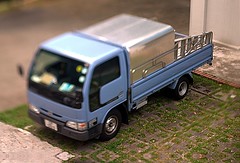

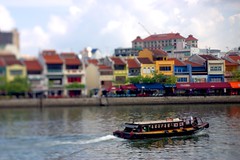
What I have found though is that the tilt shift lens makes for interesting portraits. Here's the current crop.
I bought an extremely old Japanese Auto Chinon 50mm prime lens second-hand the other day, so I could play about with creating a new tilt shift lens for my Canon 300D.
I've been playing about with mounting options, and believe it or not the most effective I have found to date is black fibre gaffer tape. It's not a permanent solution at all, but until I find one that is it will have to do.
This is a test shot hurriedly scraped together on the first day or lens creation.
It's a random page of The Economist, taken at an angle. With a normal lens you'd expect a band of words to appear focused, with the foreground and background out of focus, but by angling the lens I was able to almost lay the plane of focus along the page (you’ll notice “Europe” is fuzzy).
As a first attempt it’s great. The lens mount (not sure what it is, but the lens is for a 35mm camera -- Pentax, I think) is much smaller than the opening for the EOS mount, so while the lens needs to settle flush to the body for perfect focus, the smaller mount means I have leeway to move the lens about in the opening.
Not bad for a $20 lens with perfect optics. Lens specs:
50mm
Aperture: f1.9-f16
Focal range: 0.4m - infinity
Manual Focus
What tilt shifting does is allow you to move the plane of focus about in accordance with the Scheimpflug Principle, which as well as allowing perfectly aligned architectural photography (sky scrapers no longer warp to the centre of the frame, but remain straight) but to also mess about and change perception of everyday objects.
Often this is referred to as the miniature effect. Here's a few not so good samples I've taken, but the bitter*girls blog has many professionally shot ones that illustrate it better than I ever could.



What I have found though is that the tilt shift lens makes for interesting portraits. Here's the current crop.
